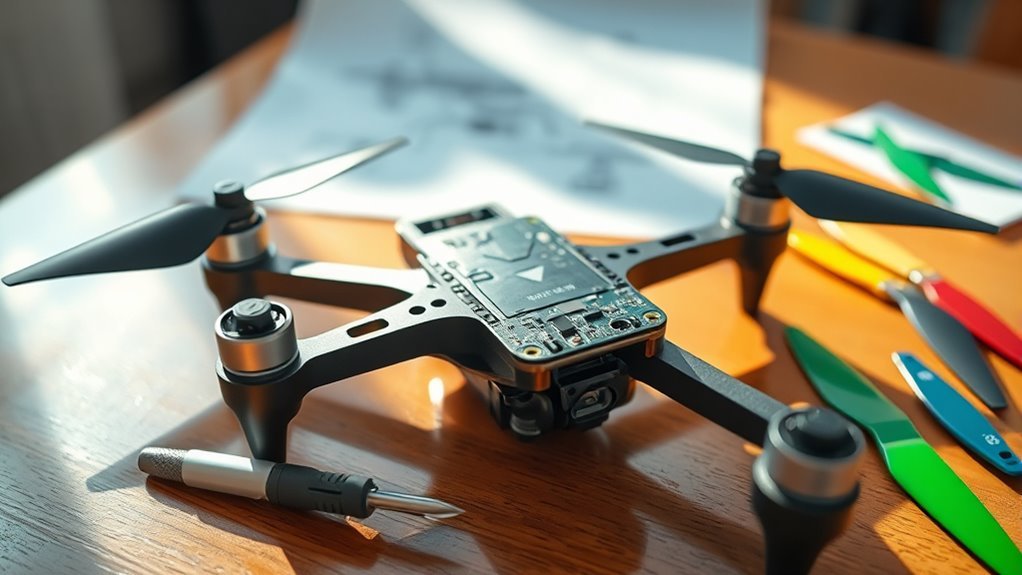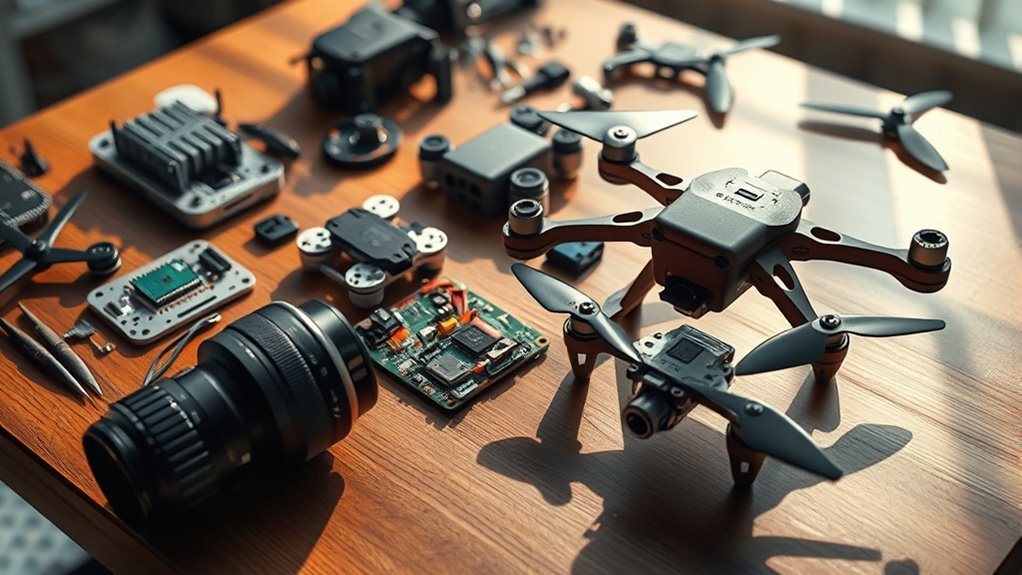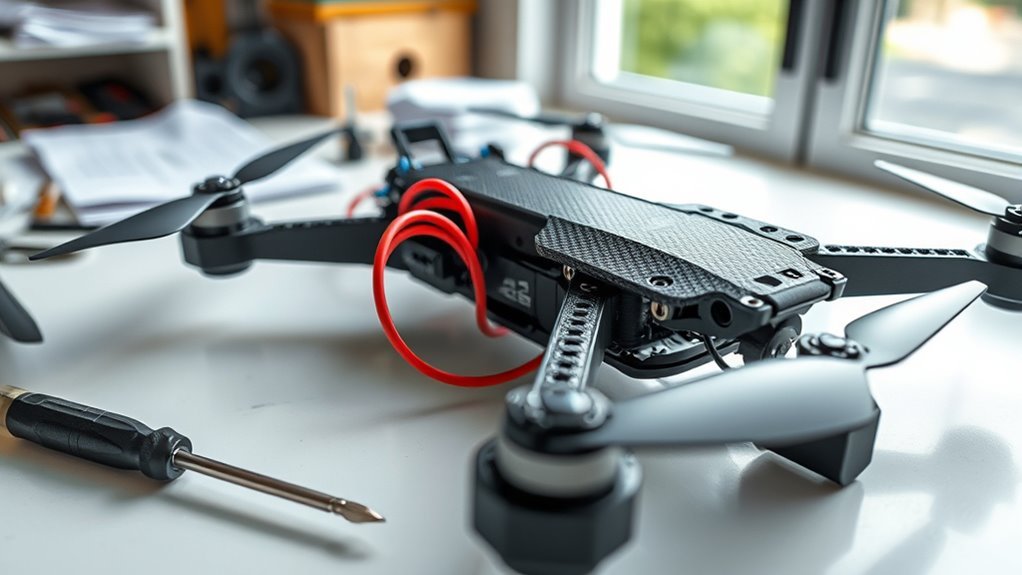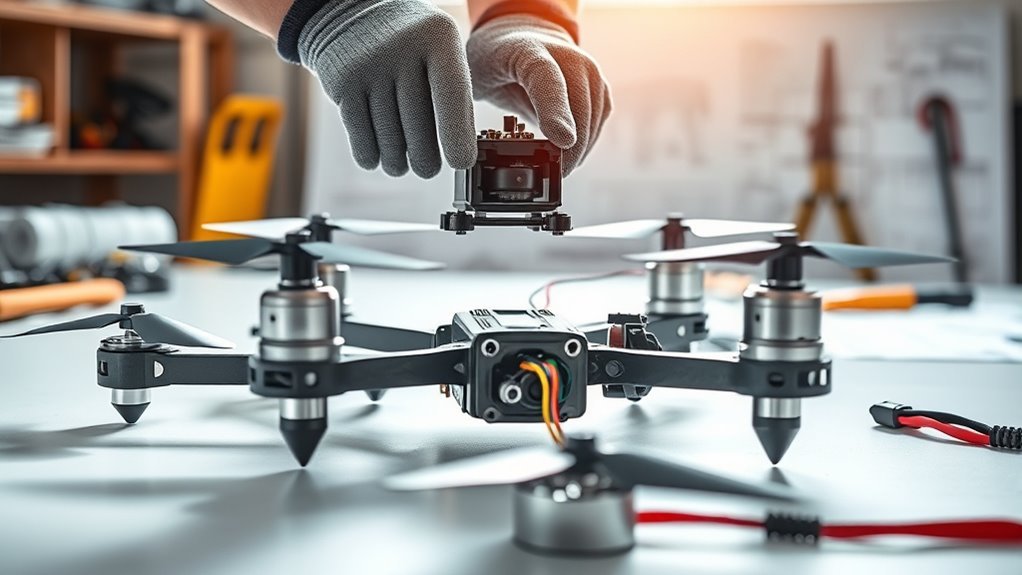To create your drone, start by choosing the right type, considering its purpose and your skill level. Gather essential components like a flight controller, motors, and battery. Next, assemble the frame using lightweight materials for durability. Install motors and propellers, guaranteeing proper alignment. Set up the flight controller, connect necessary components, and configure the software. Finally, test and fine-tune the drone to guarantee peak performance and stability. There’s more to explore for maximizing your drone’s capabilities.
Choose Your Drone Type

When selecting a drone type, what factors should you consider? First, define your purpose selection. Are you capturing aerial photography, racing, or surveying land? Each drone type serves specific functions. For instance, a quadcopter is ideal for stability and versatility in photography, while a racing drone offers speed and agility for competitive flying.
Next, assess your skill level. Beginners might prefer ready-to-fly models, whereas experienced pilots can handle customizable kits. Battery life and range are also critical; longer flight times and distances enhance freedom during use. Additionally, be aware that weight capacity constraints can impact your drone’s performance when carrying payloads. Finally, consider regulations in your area, as they can dictate what drone types are permissible. Balancing these factors guarantees you choose a drone that aligns with your objectives and enhances your flying experience. Additionally, consider flight stability as it impacts how well the drone performs in various conditions.
Gather Essential Components

Gathering essential components is crucial to building a functional drone that meets your specific needs. Start by selecting a flight controller, motors, and electronic speed controllers (ESCs) tailored for your drone type. Verify component compatibility; mismatched parts can lead to performance issues or complete failure. Don’t forget the propellers and battery, as they directly influence flight time and stability. Essential tools like a soldering iron, multimeter, and screwdrivers will facilitate assembly and troubleshooting. Consider additional components such as GPS modules or cameras if you want advanced features, as flight performance comparison indicates that incorporating quality components can significantly enhance your drone’s capabilities. Thoroughly research each part to confirm they align with your vision of freedom in flight. This meticulous approach sets the foundation for a successful drone build, empowering you to explore the skies with confidence. Additionally, employing advanced AI integration in your drone’s software can enhance operational efficiency and minimize potential issues during flight.
Assemble the Frame

Assembling the frame is a critical step that lays the groundwork for your drone’s structure and stability. You’ll need to choose the right frame materials and apply effective assembly techniques to guarantee durability. Here are some key considerations:
- Material Selection: Opt for lightweight yet strong materials like carbon fiber or aluminum to enhance performance.
- Joint Techniques: Use techniques such as screws, adhesives, or soldering for secure connections that withstand vibrations.
- Frame Design: Confirm your design accommodates all components, providing adequate space for wiring and future upgrades.
Install the Motors and Propellers
Installing the motors and propellers is essential for your drone’s flight capabilities. Begin by securing the motors to the frame, confirming proper motor alignment to avoid unnecessary strain. Misalignment can lead to instability during flight. Next, attach the propellers, paying close attention to propeller balance; unbalanced propellers can cause vibrations that affect flight performance.
| Step | Action | Notes |
|---|---|---|
| 1 | Secure motors to the frame | Check for tight connections |
| 2 | Align motors correctly | Use a level for accuracy |
| 3 | Attach propellers | Match rotation direction |
| 4 | Check propeller balance | Use a propeller balancer |
| 5 | Test for stability | Conduct a ground test |
This meticulous approach guarantees your drone’s peak performance.
Set Up the Flight Controller
Once you’ve secured the motors and propellers, setting up the flight controller is essential for ensuring your drone operates effectively. You’ll need to choose between several flight controller types, like multi-rotor or fixed-wing, based on your drone’s design. Here are some installation tips to help you out:
- Mount the controller securely to avoid vibrations that could affect performance. This will help ensure that the controller can accurately process real-time data for optimal flight management.
- Connect the ESCs and motors according to the manufacturer’s layout, ensuring proper orientation.
- Verify power supply connections to prevent any malfunctions during flight.
Following these steps will set a solid foundation for your drone’s flight capabilities. A well-installed flight controller is vital for achieving the freedom of flight you desire. Additionally, consider implementing advanced safety features to enhance your drone’s operational reliability during its flights.
Configure the Software
To configure the software for your drone, you’ll need to choose suitable flight control software that meets your operational requirements. After selecting the software, make sure you install any necessary drivers to facilitate communication between the hardware and software. Finally, set up the parameters to optimize flight performance and guarantee stability during operation.
Choose Flight Control Software
How do you guarantee peak performance and stability in your drone? It starts with choosing the right flight control software. You’ll want to take into account options that provide robust performance and flexibility. Here are some key factors to evaluate:
- Open source options: These can offer greater customization and community support, allowing you to tailor the software to your needs.
- Software compatibility: Make sure the software you choose integrates seamlessly with your hardware components, including sensors and GPS.
- User interface: A clean, intuitive interface can greatly enhance your operational experience.
Install Necessary Drivers
After selecting the right flight control software, the next step involves installing the necessary drivers to confirm that your drone’s hardware communicates effectively with the software. First, verify driver compatibility by checking the manufacturer’s website for the latest versions. Download the required drivers, as outdated or mismatched drivers can lead to communication errors. During the installation process, follow on-screen prompts carefully; this step is essential to establish a solid connection between your flight controller and the software. Once installed, it’s wise to reboot your system to finalize the setup. Confirm the drivers are operational by running a connection test within the software. This meticulous approach guarantees your drone’s components work harmoniously, maximizing your freedom to explore the skies.
Set Up Parameters
Setting up parameters is essential for maximizing your drone’s performance and guaranteeing safe operation. Properly configuring your drone’s software allows you to customize flight specifications to suit your needs. Here are key aspects to take into account:
- Flight Modes: Select between manual, GPS, or altitude hold modes for ideal control.
- Altitude Limits: Set maximum and minimum altitude parameters to avoid legal issues and guarantee safe flights.
- Speed Settings: Adjust speed limits to suit your flying environment, enhancing both safety and agility.
Test and Fine-Tune Your Drone
Once your drone is assembled, testing and fine-tuning become critical to confirm peak performance. You’ll want to employ effective drone calibration techniques to ascertain all systems are functioning at their best. Start with basic flight stability adjustments; these can make a significant difference in your drone’s responsiveness and control. Ensuring that your drone has advanced GPS integration is essential for achieving superior navigation accuracy during missions. Additionally, utilizing thermal imaging capabilities can enhance your drone’s functionality in various scenarios.
| Adjustment Type | Importance |
|---|---|
| Calibration Techniques | Confirms sensors are accurate |
| Stability Adjustments | Enhances control and handling |
| Battery Management | Maximizes flight time |
Frequently Asked Questions
What Is the Average Cost of Building a Drone?
The average cost of building a drone varies greatly, depending on the components you choose. Budget considerations are vital; high-quality parts can range from a few hundred to several thousand dollars, impacting your overall expenditure.
How Long Does It Take to Build a Drone?
The drone assembly timeline varies, typically ranging from a few hours to several days. Build quality factors, like complexity and component selection, greatly influence this duration, impacting both performance and your overall satisfaction with the final product.
Can I Use Recycled Parts for My Drone?
Yes, you can use recycled materials for your drone components. However, verify they’re compatible and in good condition. It’s a sustainable choice that can provide unique advantages, but testing for reliability is essential for performance.
What Safety Gear Do I Need While Building a Drone?
When building your drone, it’s essential to have your ducks in a row. Wear safety goggles to protect your eyes and heat-resistant gloves to handle components safely, ensuring a secure and enjoyable building experience.
Are There Legal Restrictions for Flying Homemade Drones?
Yes, there’re legal restrictions for flying homemade drones. You must guarantee regulatory compliance with local laws, which often include flight restrictions regarding altitude, no-fly zones, and registration requirements to maintain your freedom in the skies.

